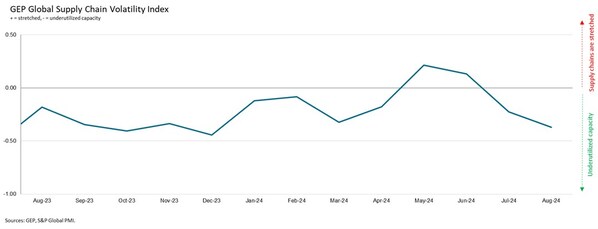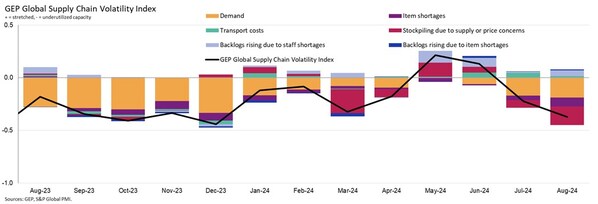GLOBAL PURCHASING ACTIVITY CONTRACTING AT STRONGEST PACE SINCE DECEMBER 2023 AS MANUFACTURERS WORLDWIDE RETRENCH: GEP GLOBAL SUPPLY CHAIN VOLATILITY INDEX


|
- North American suppliers report strong rise in excess capacity and the softest demand in eight months, with flagging factory conditions in the U.S.
- Asian suppliers, who experienced growth in the first half of 2024, report spare capacity as Chinese procurement declines
- Europe's manufacturing recession deepened in August, with Germany and France driving the continent's downturn
- In contrast to the EU, UK manufacturers close to full utilization
CLARK, N.J., Sept. 11, 2024 /PRNewswire/ -- The GEP Global Supply Chain Volatility Index — a leading indicator tracking demand conditions, shortages, transportation costs, inventories and backlogs based on a monthly survey of 27,000 businesses — fell to -0.37 in August. This is its lowest level year-to-date (vs. -0.22 in July), signaling the highest level of spare capacity at global suppliers in 2024. This marked two successive months of underutilized capacity across the world's supply chains, and the lowest level of input demand in eight months, as global economic conditions deteriorate.

GEP Global Supply Chain Volatility Index. Interpreting the data: Index > 0, supply chain capacity is being stretched. The further above 0, the more stretched supply chains are. Index < 0, supply chain capacity is being underutilized. The further below 0, the more underutilized supply chains are.
Suppliers in all parts of the globe experienced a slowdown in activity during August. Conditions in North America were the weakest — in fact, vendors used by manufacturers in the region recorded the greatest level of unused capacity since June 2023. Factories in all three of the continent's economies, but especially the U.S., recorded lower purchasing activity in August, as a result of months of below-average demand, highlighting a diminished near-term outlook.
For the first time since March, our data shows spare capacity across Asian supply chains. Procurement activity in China weakened, which was a key driver of August's downturn in vendor activity, offsetting strength in India.
Europe's manufacturing recession continued to dampen supply chains and even worsened further, with the continent's big-two economies, Germany and France, spearheading manufacturing weakness. In contrast to the continent, U.K. manufacturers are close to full utilization.
"What is most concerning in our August data is that manufacturers are aggressively drawing down their inventory suggesting they're preparing for a sustained soft patch," explained Neha Shah, president, GEP. "To head off a material slowdown in the second half of the year, manufacturers need to see interest rates lowered, and for the U.S., China and the EU to avoid raising tariffs and trade barriers."
AUGUST 2024 KEY FINDINGS
- DEMAND: Global demand for raw materials, commodities and other necessary components like semiconductors shrank in August at an accelerated pace that was the strongest in the year-to-date. The globe's two economic powerhouses, the U.S. and China, both reported lower procurement activity, as well as other major manufacturing hubs like Germany.
- INVENTORIES: Safety stockpiling was reduced to the greatest extent since March. Reports from global businesses of inventories rising because of supply or price concerns were well below historically typical levels as firms targeted cost savings and lean inventory management amid softening economic conditions.
- MATERIAL SHORTAGES: Reports of item shortages fell for a second successive month and were their lowest since January 2020 as weaker demand had clearly boosted vendor stock levels.
- LABOR SHORTAGES: Reports of manufacturers' backlogs because of insufficient staffing capacity were muted in August, holding close to their long-term trend level. This indicates that labor supply is generally capable of meeting demand.
- TRANSPORTATION: After having risen in recent months and reaching the highest level since October 2022 in June and July, global transportation costs cooled slightly in August. They were still slightly greater than their long-term average, however.
REGIONAL SUPPLY CHAIN VOLATILITY
- NORTH AMERICA: Index fell sharply to -0.62, from -0.11, signaling the highest level of vendor spare capacity since June 2023. Procurement activity in the U.S. was the weakest across the region during August.
- EUROPE: Index decreased to -0.53, from -0.49 as the continent's industrial recession intensified. Factory demand in Germany and France was deteriorating rapidly.
- U.K.: Index slipped back into negative territory, falling from 0.11 to -0.14, signaling slack in U.K. supply chains for first time since April.
- ASIA: Index fell to -0.07, from 0.07, indicating underutilized capacity at suppliers to Asia for first time in five months. Although factory activity remains robust in India, procurement managers in China reported cutbacks.
For more information, visit www.gep.com/volatility.
Note: Full historical data dating back to January 2005 is available for subscription. Please contact economics@spglobal.com.
The next release of the GEP Global Supply Chain Volatility Index will be 8 a.m. ET, October 10, 2024.
About the GEP Global Supply Chain Volatility Index
The GEP Global Supply Chain Volatility Index is produced by S&P Global and GEP. It is derived from S&P Global's PMI® surveys, sent to companies in over 40 countries, totaling around 27,000 companies. The headline figure is a weighted sum of six sub-indices derived from PMI data, PMI Comments Trackers and PMI Commodity Price & Supply Indicators compiled by S&P Global.
- A value above 0 indicates that supply chain capacity is being stretched and supply chain volatility is increasing. The further above 0, the greater the extent to which capacity is being stretched.
- A value below 0 indicates that supply chain capacity is being underutilized, reducing supply chain volatility. The further below 0, the greater the extent to which capacity is being underutilized.
About GEP
GEP® delivers AI-powered procurement and supply chain solutions that help global enterprises become more agile and resilient, operate more efficiently and effectively, gain competitive advantage, boost profitability and increase shareholder value. Fresh thinking, innovative products, unrivaled domain expertise, smart, passionate people — this is how GEP SOFTWARE™, GEP STRATEGY™ and GEP MANAGED SERVICES™ together deliver procurement and supply chain solutions of unprecedented scale, power and effectiveness. Our customers are the world's best companies, including more than 1,000 Fortune 500 and Global 2000 industry leaders who rely on GEP to meet ambitious strategic, financial and operational goals. A leader in multiple Gartner Magic Quadrants, GEP's cloud-native software and digital business platforms consistently win awards and recognition from industry analysts, research firms and media outlets, including Gartner, Forrester, IDC, ISG, and Spend Matters. GEP is also regularly ranked a top procurement and supply chain consulting and strategy firm, and a leading managed services provider by ALM, Everest Group, NelsonHall, IDC, ISG and HFS, among others. Headquartered in Clark, New Jersey, GEP has offices and operations centers across Europe, Asia, Africa and the Americas. To learn more, visit www.gep.com.
About S&P Global
S&P Global (NYSE: SPGI) S&P Global provides essential intelligence. We enable governments, businesses and individuals with the right data, expertise and connected technology so that they can make decisions with conviction. From helping our customers assess new investments to guiding them through ESG and energy transition across supply chains, we unlock new opportunities, solve challenges and accelerate progress for the world. We are widely sought after by many of the world's leading organizations to provide credit ratings, benchmarks, analytics and workflow solutions in the global capital, commodity and automotive markets. With every one of our offerings, we help the world's leading organizations plan for tomorrow, today.
Media Contacts | ||
Derek Creevey | Joe Hayes | S&P Global Market Intelligence |
Director, Public Relations | Principal Economist | Email: Press.mi@spglobal.com |
GEP | S&P Global Market Intelligence | |
Phone: +1 646-276-4579 | Phone: +44-1344-328-099 | |
Email: derek.creevey@gep.com | Email: joe.hayes@spglobal.com |

GEP Global Supply Chain Volatility Index. GEP Global Supply Chain Volatility Index. Interpreting the data: Index > 0, supply chain capacity is being stretched. The further above 0, the more stretched supply chains are. Index < 0, supply chain capacity is being underutilized. The further below 0, the more underutilized supply chains are.








